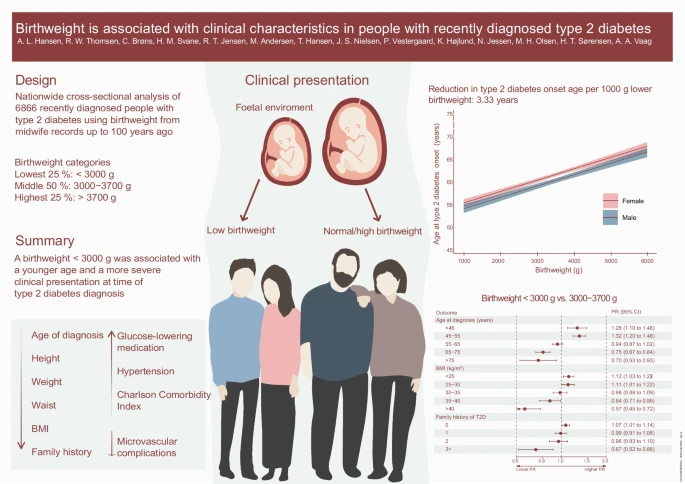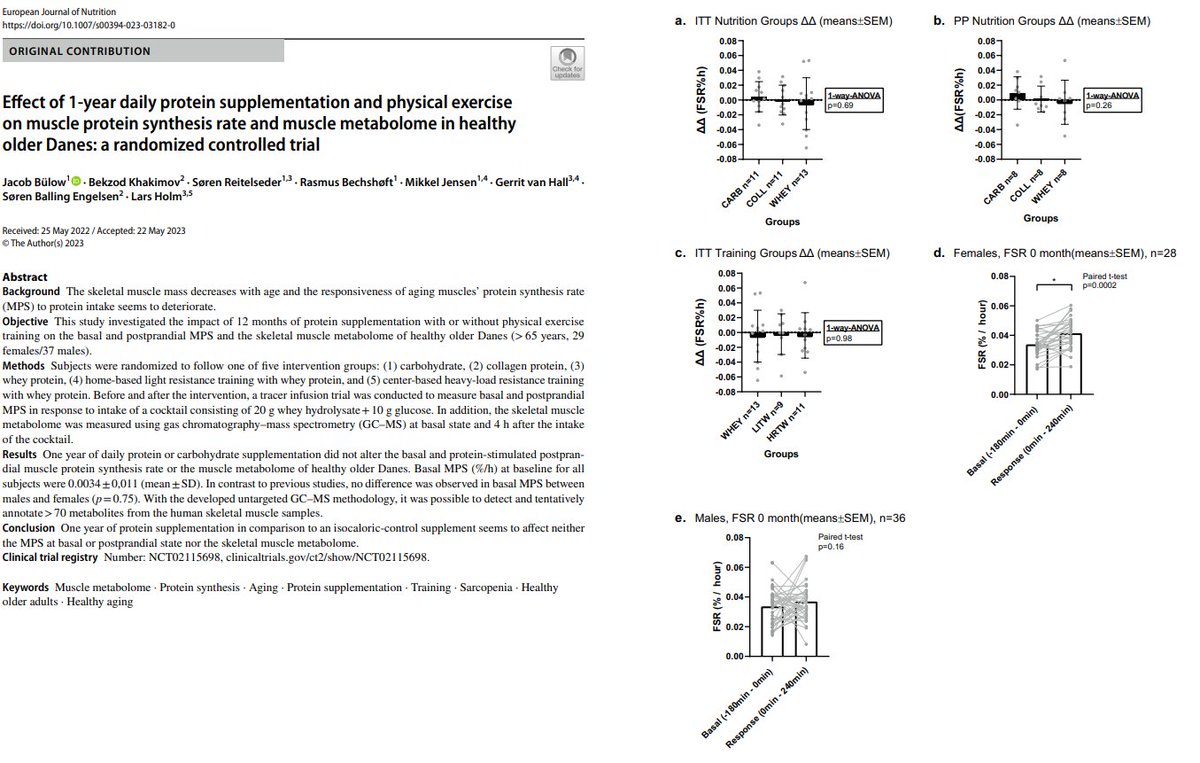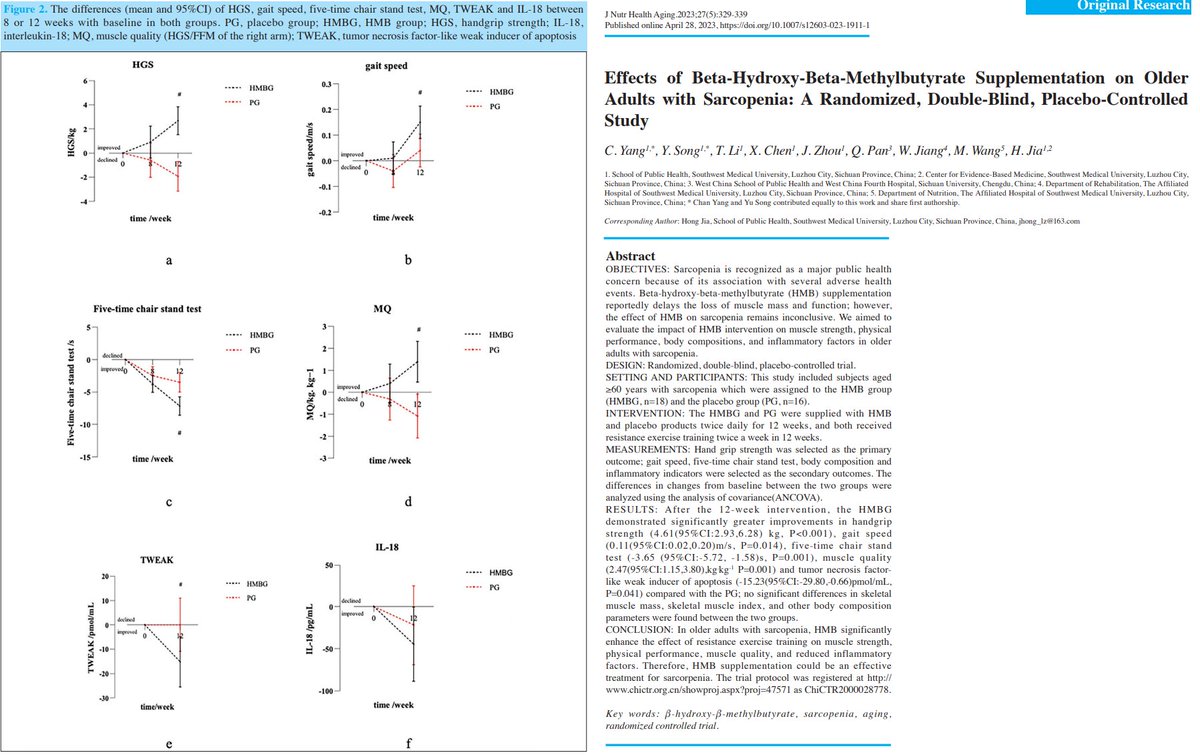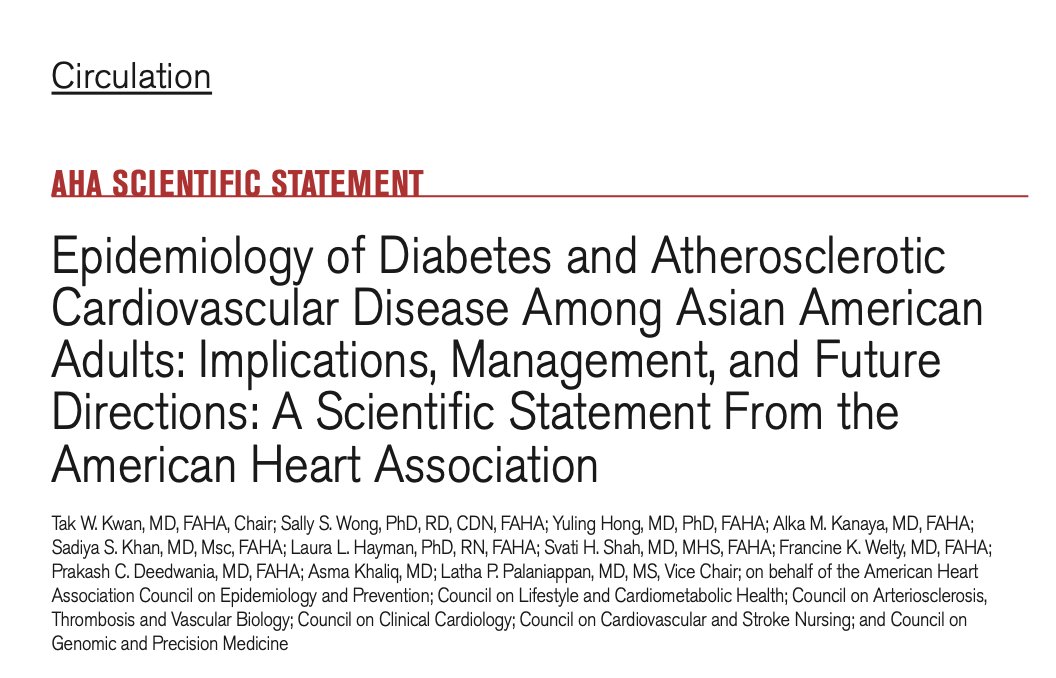Discover and read the best of Twitter Threads about #Diet
Most recents (24)
This systematic review finds that overall the literature suggests that daily low-carbohydrate intake is not likely to negatively affect psychological well-being, or that this type of diet is worse than any other in this respect. 

- This systematic review evaluated the impact of a carbohydrate-restricted or ketogenic diet on psychological outcomes.
- The potential synergistic effect of carbohydrate restricted diets/ketogenic diets and physical activity or social factors on psychological outcomes was also considered.
The findings of this one in mice suggest that dietary nitrate is capable of preserving mitochondrial bioenergetics during skeletal muscle disuse, and maintain mitochondrial-specific function during short-term (but not long-term) limb immobilization. 

- Skeletal muscle disuse reduces muscle protein synthesis rates and induces atrophy, events associated with decreased mitochondrial respiration and increased reactive oxygen species (ROS).
- Since dietary nitrate can improve mitochondrial bioenergetics, this study examined whether nitrate supplementation attenuates disuse-induced impairments in mitochondrial function and muscle protein synthesis rates.
Here, despite younger age at diagnosis, lower prevalence of obesity and diabetes family history, individuals with recently diagnosed type 2 diabetes who had a low birthweight were more likely to have greater use of glucose-lowering medications and a larger burden of comorbidity. 

- Low birthweight is a risk factor for type 2 diabetes but it is unknown whether low birthweight is associated with distinct clinical characteristics at disease onset.
- This study examined whether a lower or higher birthweight in type 2 diabetes is associated with clinically relevant characteristics at disease onset.
This one provides genetically proxied evidence to support that FGF21 signaling may reduce chronic kidney disease risk, have favorable effects across a broad range of renal outcomes and cardiometabolic risk factors. 

- Fibroblast growth factor 21 (FGF21) is a fasting or stress inducible metabolic hormone produced mainly in the liver.
It plays important roles in regulating glucose and lipid homeostasis, as well as bone homeostasis.
It plays important roles in regulating glucose and lipid homeostasis, as well as bone homeostasis.
- This study leveraged a missense genetic variant, rs739320 in the FGF21 gene, that associates with magnetic resonance imaging-derived liver fat as a clinically validated and biologically plausible instrumental variable for studying the effects of FGF21 analogs.
This systematic review and meta-analysis suggests that the dietary resemblance between parents and children are most likely to be weak to moderate for most aspects of dietary intakes.
- There is a strong societal belief that parents are role models for their child's dietary behaviours in early life that may persist throughout the life course.
Evidence has shown inconclusive dietary resemblance in parent-child pairs.
Evidence has shown inconclusive dietary resemblance in parent-child pairs.
- This systematic review and meta-analysis aimed to examine dietary resemblance between parent and children.
In this one, the authors report the development and validation of the Essential Amino Acid-9 (EAA-9) score, an innovative, nutrient-based protein quality scoring framework, which allows for personalization of essential amino acid needs based on age or metabolic conditions. 

- Currently, recognition of essential amino acid requirements is embedded within a generalized measure of protein quality known as PDCAAS (Protein Digestibility-Corrected Amino Acid Score).
- Calculating PDCAAS includes the FAO/WHO/UNU amino acid score (AAS), which is based on the limiting amino acid in a food, that is, the single amino acid with the lowest concentration compared to the reference standard.
The findings of this one suggest that dietary carbohydrate and exercise may generate independent and interactive effects on the plasma metabolome, resulting in the generation of distinct metabolic phenotypes that may influence appetite regulation and perhaps energy intake. 

- This study aimed to determine the interactive effects of carbohydrate and exercise on the plasma hormonal and metabolite responses and explore potential mediators of exercise-induced changes in appetite and energy intake across nutritional states.
- In a randomised-crossover fashion, 12 male participants completed four study visits that involved the consumption of a control (water) or carbohydrate beverage (75 g maltodextrin, 300 kcal), followed by a 30-minute rest or exercise session (75% V'O2max on a cycle ergometer).
In this one, even though the consumption of 42.5g mixed nuts per day for 16 weeks was associated with some favorable cardiometabolic risk factor changes, it was not associated with statistically significant changes on LDL-c or Lp(a) in individuals with overweight and obesity. 

- The aim of this randomized controlled trial was to examine the effects of mixed nut supplementation on Lp(a), lipid profiles, and inflammation in individuals with overweight and obesity.
- Participants randomly assigned to the intervention group were provided with 42.5 g/day packets of mixed nuts consisting of 25.5 g of nut mixture (cashews, almonds, macadamia nuts, Brazil nuts, pecans), 5 g of pistachios, 5 g of walnuts, and 7 g of peanuts.
The findings of this meta‐analysis suggest that combined intake of DHA + EPA is likely to lower triglyceride and non-HDL-c, especially when the dose is more than 2 g/day. 

- Evidence of an approximately linear dose–response relationship for triglyceride and non‐HDL‐C reduction among the general population and especially in populations with hyperlipidemia and overweight/obesity was observed.
- These inverse correlations were more prominent in participants receiving basal lipid‐lowering medications or with pre-existing coronary heart disease, given the intake dose was higher than 2 g/d.
In this one in middle-aged Japanese individuals, body cell mass, a metabolically active component of Fat-Free Mass and a representative biomarker of muscle cell mass, was associated cardiorespiratory fitness, as measured by V'O2peak. 

- Fat-free mass (FFM) is a heterogeneous compartment comprising body cell mass (BCM), intracellular water (ICW), extracellular solids, and extracellular water (ECW).
- Fat-free mass (FFM), considering as a metabolically active compartment of the human body, is often used to adjust for differences in resting or exercise-state energy metabolism, including maximal oxygen uptake (V'O2peak), to account for body composition.
Here, one year of protein supplementation in comparison to an isocaloric-control supplement appeared to affect neither the muscle protein synthesis rate at basal or postprandial state nor the skeletal muscle metabolomein healthy older Danes. 

- The skeletal muscle mass decreases with age and the responsiveness of aging muscles protein synthesis rate to protein intake seems to deteriorate.
- This study investigated the impact of 12 months of protein supplementation with or without physical exercise training on the basal and postprandial muscle protein synthesis and the skeletal muscle metabolome of healthy older Danes (> 65 years, 29 females/37 males).
This systematic review and meta-analysis of randomized controlled trials suggests that exercise combined with dietary advice is likely to be a more effective approach for old cancer survivors to improve physical functioning compared with exercise alone. 

- This study aimed to evaluate the effect of exercise with or without dietary advice on muscle mass, muscle strength and physical functioning (including perceived physical functioning and physical performance) in old cancer survivors.
- Data from 21 trials were included in this study, including 16 exercise trials and 5 exercise + dietary advice studies.
This one in mice suggests that a daily feeding-fasting rhythm is a key input to liver and muscle clocks that enables synergy between the two tissues for control of glucose metabolism at the systemic level. 

- Physiology is regulated by interconnected cell and tissue circadian clocks.
- Disruption of the rhythms generated by the concerted activity of these clocks is associated with metabolic disease.
This one found that Chinese adolescents’ sugar-sweetened beverage consumption is common, and that a high-frequency sugar-sweetened beverage consumption to be associated with lower muscle strength in that population. 

- The proportions of Chinese adolescents who consumed sugar-sweetened beverage ≥ 3 times/week, 1–2 times/week, and < 1 time/week were 12.23%, 52.79%, and 34.98%, respectively.
- These findings suggest that more than 60% of adolescents in China consume sugary beverages more than once a week or more.
In this one in individuals with prediabetes, long-term almond consumption was associated with adverse effects on insulin sensitivity and glucose metabolism, as they were added to the habitual diet and did not fully replace other foods. 

- This study tried to examine the effects of long-term almond consumption in males and females with prediabetes on glucose metabolism side-by-side via the clamp technique, in the postprandial state, and in real life conditions using continuous glucose monitors.
- Forty-three participants volunteered in this randomized, cross-over trial with a 5-months control and intervention period and a 2-months wash-out.
This systematic review and meta-analysis of observational studies suggests that individuals who consume dairy products are likely to have a reduced risk of developing NAFLD. 

- Pooled risk estimates for any dairy consumption and NAFLD occur rence revealed modest, yet consistent inverse associations.
- Regarding individual dairy products, those who consumed milk and yogurt were more likely to have a modestly lower occurrence of NAFLD.
In this one, HMB supplementation was associated with improvements in muscle strength, physical performance and muscle quality (defined as the handgrip strength/fat-free mass ratio) in older adults with sarcopenia during a resistance exercise program. 

- This randomized, double-blind, placebo-controlled study aimed to evaluate whether HMB supplementation can improve muscle strength, function, and body composition in older adults with sarcopenia.
- This study included subjects aged ≥60 years with sarcopenia which were assigned to the HMB group or the placebo group.
This umbrella review finds that the evidence from meta-analyses of Randomised Controlled Trials overall suggests that resistance training is likely to be a suitable intervention for persons with sarcopenic obesity, although the results may be suboptimal, in general.
- This is the first umbrella review on sarcopenic obesity conducted to provide comprehensive insights into the effectiveness of different nutrition and exercise interventions for adults.
- Four systematic reviews with between 30 to 225 participants were included in the umbrella review.
This systematic review and meta-analysis finds little evidence for or against recommending the dietary inclusion of legumes for the purpose of cardiovascular disease and type 2 diabetes prevention for healthy general populations.
- This study aimed to systematically review the evidence for associations between consumption of legumes and cardiovascular disease, type 2 diabetes and their risk factors among healthy adults using both observational and intervention studies.
- Findings from observational studies (generally with low legume consumption) did not support an association, although clinical trials did indicate some likely beneficial (although clinically small) effects on blood lipids and fasting glucose.
Here, even though both acute and short-term supplementation with nitrate-rich beetroot juice were found to have equally beneficial effects on muscle speed and power in older individuals, no apparent changes in blood pressure or plasma markers of oxidative stress were observed. 

- Sixteen community-dwelling older men and women with a mean age of 71 years completed this registered clinical trial.
- The participants not on the placebo group drank 140 mL of concentrated beetroot juice containing (based on direct measurement) 18.2±6.2 of NO3-.
This study aimed to identify risk phenotypes for sarcopenia in apparently healthy youth aged 10–18 years, using clustering analysis procedures based on body composition and musculoskeletal fitness.
- Two risk phenotypes for sarcopenia were identified in apparently healthy young people:
* a low lean body mass index phenotype with low BMI
* a lean body mass/fat body mass ratio phenotype with high BMI and fat body mass index.
* a low lean body mass index phenotype with low BMI
* a lean body mass/fat body mass ratio phenotype with high BMI and fat body mass index.
In both risk phenotypes, musculoskeletal fitness was low.
Food addiction is real and is related to #obesity and #diabetes
1. Food #addiction (FA) syndrome can be diagnosed by using Yale Food Addiction Scale (YFAS). There are 11 possible symptoms, which can be used to diagnose FA, as well as grade its severity.
#Diet #MedTwitter
1. Food #addiction (FA) syndrome can be diagnosed by using Yale Food Addiction Scale (YFAS). There are 11 possible symptoms, which can be used to diagnose FA, as well as grade its severity.
#Diet #MedTwitter

2. Clinical diagnosis of food addiction (FA)
Individuals can meet a “diagnostic” score for FA on the current versions of the YFAS by endorsing at least two of the 11 behavioral indicators of addiction plus clinical impairment/distress.
#psychtwitter
Individuals can meet a “diagnostic” score for FA on the current versions of the YFAS by endorsing at least two of the 11 behavioral indicators of addiction plus clinical impairment/distress.
#psychtwitter
3. Severity of Food addiction
Severity thresholds for this “diagnostic” score are defined by the number of symptoms endorsed
(mild: 2–3 symptoms;
moderate: 4–5 symptoms;
severe: 6–11 symptoms)
Severity thresholds for this “diagnostic” score are defined by the number of symptoms endorsed
(mild: 2–3 symptoms;
moderate: 4–5 symptoms;
severe: 6–11 symptoms)
7 Simple Life Hacks for You! A twitter thread...
Here are simple tips to improve your #life and feel the difference. Here’s how you can do it:
Here are simple tips to improve your #life and feel the difference. Here’s how you can do it:

Epidemiology of Diabetes and Atherosclerotic Cardiovascular Disease Among Asian American Adults: Implications, Management, and Future Directions: A Scientific Statement From the American Heart Association: @CircAHA
Nice statement on high risk group
Summary 👇👇👇
Nice statement on high risk group
Summary 👇👇👇

1/ 🌏 Asian Americans (AsA) are the fastest growing ethnic group in the US 🇺🇸. They face high risks of Type 2 diabetes (T2D) & atherosclerotic cardiovascular disease (ASCVD) - major risks.
2/ 📊 Yet, most studies lump all AsA subgroups in one category, potentially hiding disparities in T2D & ASCVD prevalence.
